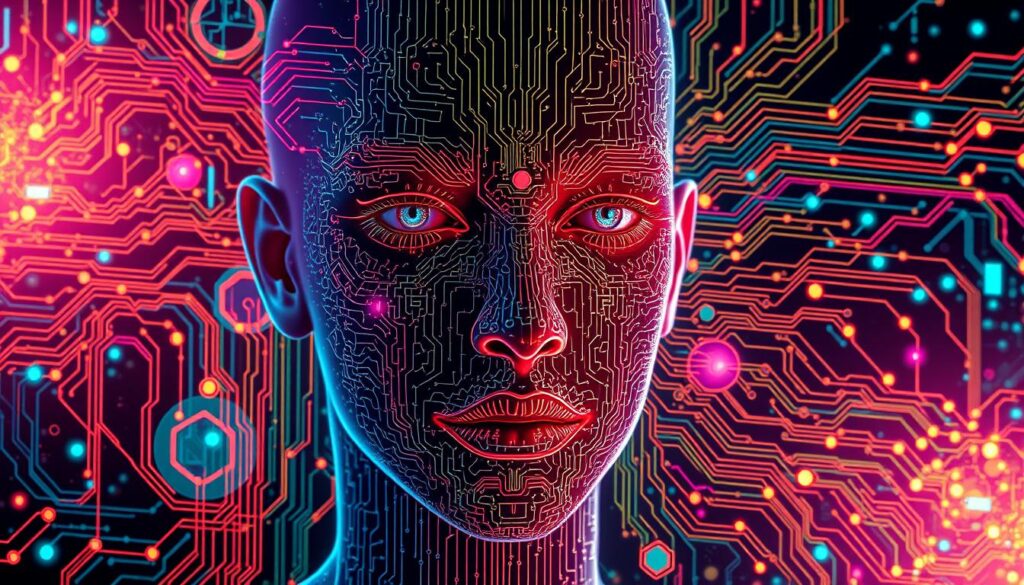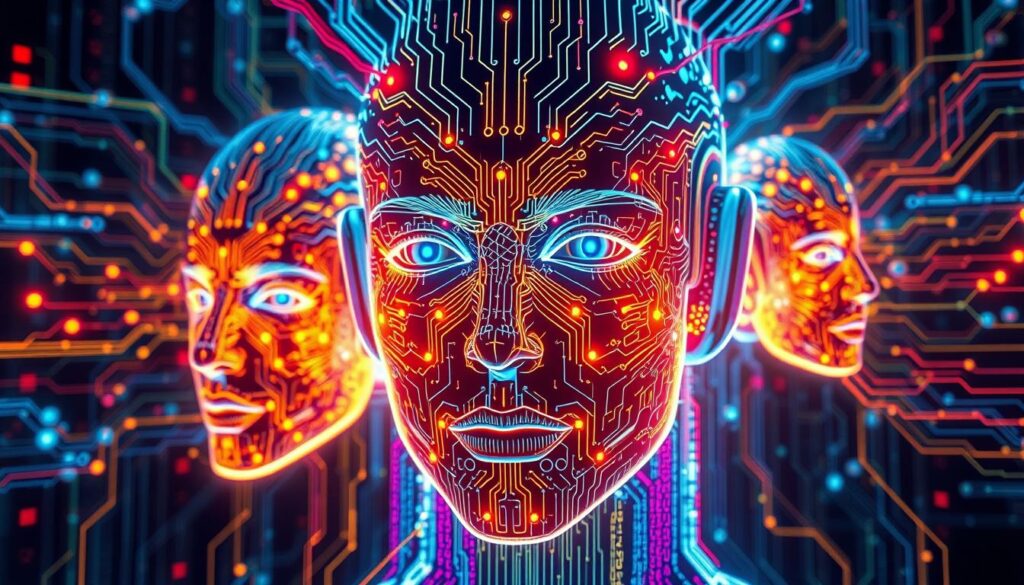Quantum computing is transforming the tech landscape, including biometrics. Its vast computational power is making facial recognition algorithms more accurate and efficient. This quantum image processing breakthrough is poised to revolutionize security, surveillance, and identity verification.
Quantum facial recognition uses quantum bits (qubits) for complex calculations and data analysis. This is beyond classical computing capabilities. Quantum computers, through quantum mechanics, can process facial images at unprecedented speeds and with unmatched precision. This opens up new avenues in quantum biometrics.
The Power of Quantum Computing in Biometrics
Quantum computing is transforming biometrics, especially facial recognition. It uses quantum systems’ unique properties to create advanced algorithms and machine learning techniques. These innovations greatly improve facial recognition systems’ accuracy and efficiency.
Quantum computing excels in handling vast amounts of facial data. Quantum computers perform calculations exponentially faster than classical ones. This capability allows them to analyze facial patterns and variations, enhancing identification processes.

Quantum machine learning algorithms are ideal for facial recognition. They efficiently learn from facial images, even with noise or lighting changes. Quantum superposition and entanglement help these models detect complex patterns that classical methods struggle with.
Quantum pattern recognition is also being explored to boost facial recognition accuracy. Quantum algorithms can quickly search through large facial image databases. This is vital for real-time applications like surveillance and border control, where speed and accuracy are paramount.
However, integrating quantum computing into biometrics poses challenges. Researchers are focusing on developing quantum algorithms that can handle noise and errors. They also aim to scale up quantum computers and create specialized hardware for biometric applications.
Despite these hurdles, quantum computing’s potential in biometrics is vast. As quantum technology evolves, facial recognition systems will see significant improvements. Quantum computing is poised to revolutionize biometrics, making identification processes more reliable and secure across various fields.
Enhancing Accuracy and Efficiency in Facial Recognition
Quantum computing is transforming facial recognition by solving the long-standing issue of balancing accuracy and speed. Traditional algorithms struggle to achieve both high precision and quick processing. But, quantum facial feature extraction and quantum image analysis are changing this.
Quantum computing allows for the development of algorithms that significantly reduce facial recognition complexity. This breakthrough leads to faster and more accurate facial feature matching. Quantum pattern matching techniques are particularly promising for enhancing facial recognition efficiency.

Companies like IBM and Google are leading the charge in quantum facial recognition. They are researching and developing quantum algorithms for biometric identification. Their work has resulted in facial recognition systems with higher accuracy and faster processing times than classical systems.
Quantum-enhanced facial recognition offers more than just better performance. It contributes to enhanced security in law enforcement, border control, and access management. Quantum facial feature extraction ensures more reliable identification, reducing false positives and negatives.
Moreover, quantum image analysis streamlines the identification process. This leads to smoother and more efficient user experiences. For instance, in mobile devices, quantum-powered facial recognition enables faster and more secure unlocking, improving both convenience and privacy.
As quantum computing advances, we can expect further breakthroughs in facial recognition. The combination of quantum facial feature extraction, quantum image analysis, and quantum pattern matching has immense potential. It promises to transform biometric identification, making facial recognition a key part of our digital lives. With its increased accuracy and efficiency, quantum computing is set to enhance security and convenience in various applications.
Quantum Algorithms for Improved Feature Extraction
Quantum computing is transforming facial recognition by introducing new methods for feature extraction. Quantum algorithms like quantum principal component analysis and quantum support vector machines are key. They efficiently extract discriminative facial features with unmatched precision.
Quantum principal component analysis uses quantum mechanics to reduce facial data dimensions. It leverages quantum superposition and entanglement to pinpoint crucial features. This approach significantly cuts down computational complexity, making facial recognition systems more efficient and accurate.
Quantum support vector machines are another crucial tool. They classify facial features by identifying the optimal hyperplane in high-dimensional spaces. This quantum computing advantage allows for better handling of complex decision boundaries, enhancing classification accuracy. It’s especially beneficial for intricate facial patterns and variations.
Researchers are also exploring quantum neural networks for learning facial representations. These networks apply quantum computing principles to model complex facial feature relationships. By using quantum algorithms in training, they can develop robust and discriminative facial representations. This leads to superior facial recognition performance.
The use of quantum algorithms in feature extraction brings several advantages:
- Enhanced accuracy: Quantum algorithms pinpoint the most discriminative facial features, boosting recognition accuracy.
- Improved efficiency: Quantum computing accelerates processing of high-dimensional facial data, reducing complexity.
- Robustness to variations: Quantum algorithms handle complex decision boundaries and learn robust facial representations. This makes them more resilient to facial appearance variations.
As quantum computing evolves, integrating quantum algorithms into facial recognition systems promises significant advancements. By harnessing quantum principal component analysis, quantum support vector machines, and quantum neural networks, we can explore new horizons in feature extraction. This will redefine the limits of facial recognition technology.
Future Implications and Challenges
Quantum computing’s rapid advancement brings immense potential to facial recognition algorithms. Quantum systems’ enhanced power and efficiency could lead to groundbreaking applications. Law enforcement might use it to quickly identify suspects and solve crimes. Border control and immigration could verify identities and prevent unauthorized entry.
Even personalized services like targeted advertising and VIP recognition at events could reach new heights with quantum facial analysis. However, this raises significant ethical considerations and challenges. The risk of data breaches and unauthorized surveillance grows as quantum computers become more accessible and facial recognition databases expand.
Developing robust quantum cryptography protocols and security measures is crucial to protect sensitive biometric data. Policymakers and technology leaders must address the potential for misuse. They need to establish clear guidelines for the responsible use of quantum facial recognition systems.
As we approach a quantum revolution in facial recognition, fostering public trust and transparency is vital. Engaging in open dialogues and involving diverse stakeholders in development is key. This ensures the technology’s ethical and socially beneficial use. By addressing these challenges and prioritizing quantum privacy and security, we can unlock the full potential of quantum facial recognition while protecting individual rights in the quantum era.
